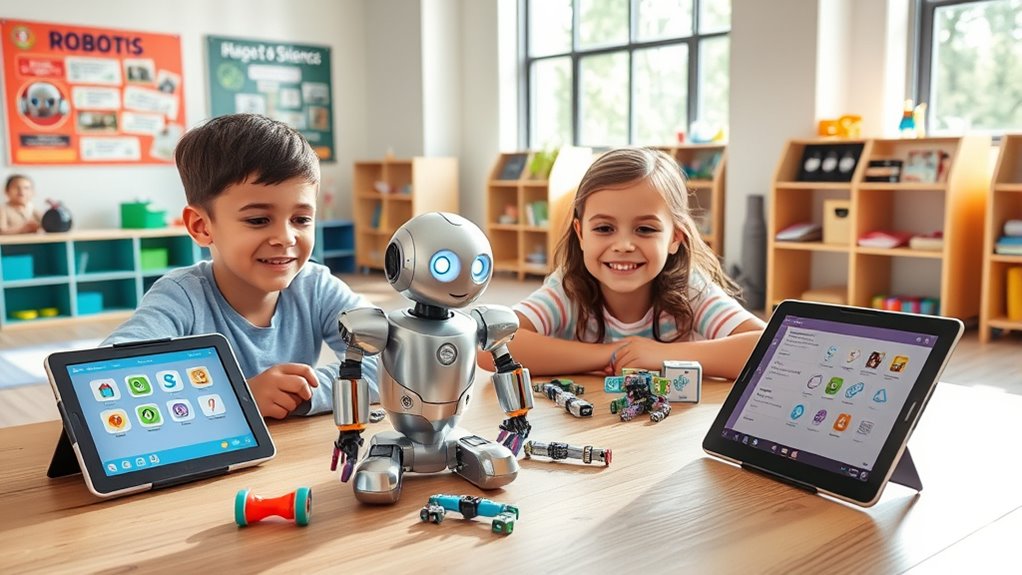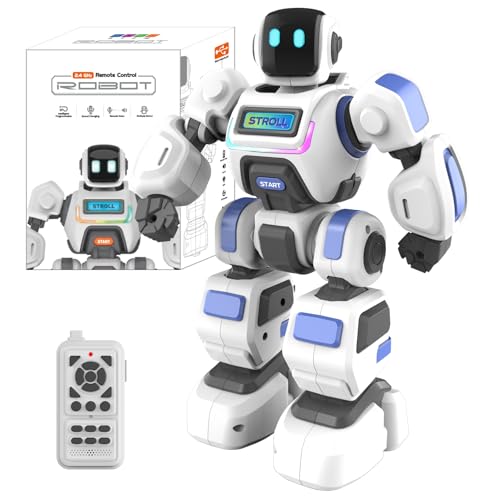Looking for the best interactive STEM robots that make learning fun and engaging? I’d recommend checking out options like Cooper the STEM Robot, Dash Robot, and solar-powered building kits like Sillbird’s 12-in-1 set. These robots offer hands-on play, coding challenges, and educational content on topics like biodiversity and engineering. They suit different ages and interests, encouraging active participation and creativity. If you keep exploring, you’ll discover even more ways these robots can inspire young learners.
Key Takeaways
- Interactive STEM robots offer engaging features like dancing, sounds, lights, and light-up effects to make learning fun.
- They include programmable actions, remote controls, gesture modes, and autonomous functions for versatile play.
- Designed for various age groups, promoting early STEM skills, problem-solving, creativity, and environmental awareness.
- Many models support screen-free play, hands-on building, and coding, fostering active learning and critical thinking.
- Safety features, easy controls, and educational content make these robots ideal for classroom, homeschooling, and family activities.
LEXiBOOK Powerman Jr. Interactive Toy Robot
If you’re looking for an interactive STEM robot that’s perfect for young children, the LEXiBOOK Powerman Jr. is an excellent choice. This smart robot can dance, play music, and reproduce animal sounds, making playtime exciting. It features an animal guessing mode where it asks yes/no questions to identify animals like cats, dogs, and even a sloth, which challenges kids’ thinking. Kids can also program up to 40 actions, creating personalized routines and dances. With a remote control for easy movement and fun sound effects, Powerman Jr. combines education and entertainment seamlessly. Its colorful design and educational extras make it a fantastic gift for curious young learners.
Best For: young children aged 3 and above who are interested in animals, music, and interactive learning through engaging, educational play.
Pros:
- Offers a wide range of interactive features including dancing, music, animal sounds, and light effects for engaging play.
- Allows programming of up to 40 actions, fostering creativity and problem-solving skills.
- Comes with educational content about planet Earth and biodiversity, enhancing learning beyond play.
Cons:
- Requires 3 AA batteries for the robot and 2 AA batteries for the remote, which are not included.
- The remote control uses infrared, which may require line-of-sight for optimal operation.
- Limited to animals like unicorn, llama, cat, dog, and sloth in the guessing game mode, possibly restricting variety.
Learning Resources Code & Go Robot Mouse Activity Set
The Learning Resources Code & Go Robot Mouse Activity Set is an excellent choice for young children aged 4 and up who are just beginning to explore programming and problem-solving. This screen-free set offers 83 pieces, including maze tiles, walls, tunnels, coding cards, and a programmable robot mouse named Colby. Kids learn sequencing, logic, and spatial reasoning by creating mazes and programming Colby with colorful buttons. Its open-ended design encourages creativity and critical thinking, making it ideal for individual or family play. The set builds confidence in STEM skills early on and provides a fun, hands-on way to introduce foundational coding concepts.
Best For: young children aged 4 and up who are beginning to explore programming, problem-solving, and STEM concepts in a hands-on, screen-free environment.
Pros:
- Promotes early STEM learning through engaging, tactile play
- Encourages creativity with customizable maze configurations and open-ended challenges
- Develops critical thinking, sequencing, and spatial reasoning skills
Cons:
- Younger children may need assistance with maze assembly and connecting pieces
- The robot mouse can occasionally go off course or miss turns, which may cause frustration
- Batteries are required but not included, and packaging does not specify this clearly
Robo Pets Robot Dog Toy for Kids
Looking for an engaging and programmable robot dog that sparks kids’ creativity? The Robo Pets Robot Dog Toy is a fantastic choice. It barks, sits, dances, performs tricks, and even walks around, making playtime exciting. Kids can control it with a remote or guide it using hand gestures in Gesture Mode. Adventure Mode lets it navigate on its own, while the programmable treats teach sequencing skills. With LED eyes, sound effects, and up to 40 minutes of playtime, it’s perfect for children ages 3 and up. Despite some remote control quirks, most kids love its fun features and interactive design.
Best For: kids aged 3 and up who enjoy interactive, programmable, and entertaining robotic pets that promote creativity and imaginative play.
Pros:
- Engaging features like barking, dancing, tricks, and autonomous walking provide varied play options.
- Programmable treats and gesture modes encourage learning sequencing and hand-eye coordination.
- LED eyes and sound effects add a fun, interactive dimension that kids enjoy.
Cons:
- Remote control buttons can be difficult to press and may sometimes be unresponsive.
- Wheels may get hair tangled or become damaged, especially on carpets, affecting mobility.
- Some users report missing accessories or product defects, along with inconsistent customer support.
RC Robot for Kids, Programmable STEM Toy with Microphone, Dancing, Singing & LED Eyes
This RC Robot for Kids stands out as an ideal choice for children aged 3 to 10 who love interactive and programmable toys. It offers a fun mix of dancing, singing, and voice interaction with three fun voice modes and LED eyes that glow brightly. The remote control, with a 20-meter microphone, lets kids operate the robot from a distance, even through walls, making active play and hide-and-seek exciting. Kids can program their own actions, dances, and patrols, encouraging creativity and STEM skills. Powered by a rechargeable battery, it provides over an hour of entertainment, all in a safe, eco-friendly design.
Best For: children aged 3 to 10 who enjoy interactive, programmable STEM toys that combine entertainment with educational activities.
Pros:
- Engages kids with dancing, singing, voice interaction, and customizable programming for creativity and STEM learning.
- Remote control with a 20-meter microphone allows for active, wall-penetrating play and hide-and-seek fun.
- Rechargeable battery provides over 60 minutes of playtime, ensuring extended entertainment in a safe, eco-friendly design.
Cons:
- May require adult supervision for programming and charging to ensure safe use.
- Some children might find the remote control and programming features complex without guidance.
- The robot’s functions and features could be limited for children older than 10 seeking more advanced STEM activities.
Activity Box Add-on for Talebot Coding Robot with Interactive Cards and STEM Games
If you’re seeking an engaging way to introduce young children to coding and STEM concepts, the Activity Box Add-on for Talebot Coding Robot is a fantastic option. It offers interactive cards, stickers, maps, and STEM games that work seamlessly with Tale-bot robots, making learning hands-on and fun. With over 256 commands, kids can explore coding fundamentals like loops and conditionals through puzzles and storytelling. The robot’s voice feedback and interactive elements keep children motivated and curious. This add-on is perfect for ages 3-9, fostering problem-solving, creativity, and social skills, whether at home or in the classroom.
Best For: parents and educators looking for an engaging, age-appropriate STEM learning tool that combines coding, storytelling, and hands-on play for children aged 3-9.
Pros:
- Promotes early coding skills with over 256 commands supporting fundamental programming concepts.
- Interactive and tactile activities, including cards, stickers, maps, and voice feedback, enhance engagement and learning.
- Suitable for both classroom and home use, fostering problem-solving, creativity, and social skills in young children.
Cons:
- Some users may experience a learning curve due to the device’s complexity and initial setup.
- Most activities have a limited duration, with some children finding the fun-to-price ratio moderate.
- Requires careful supervision to maximize educational benefits and prevent loss of interactive components.
STEM 13-in-1 Solar Power Robotics Kit for Kids
The STEM 13-in-1 Solar Power Robotics Kit is an excellent choice for kids aged 8 to 12 who are curious about renewable energy and engineering. It includes 13 different robot models that can move on land or water, built by reassembling gears, plates, tires, and shafts. The parts are easy to disassemble and reuse, encouraging creativity and problem-solving. Made from non-toxic ABS plastic, it’s safe and durable for repeated play. Powered by a solar engine, it teaches children about sustainable energy and scientific principles. Perfect for family projects or independent exploration, this kit makes learning about STEM fun and engaging.
Best For: kids aged 8-12 who are interested in renewable energy, engineering, and hands-on STEM learning.
Pros:
- Encourages creativity, problem-solving, and engineering skills through multiple robot designs.
- Made from safe, non-toxic ABS plastic with smooth edges for child safety.
- Promotes environmental awareness by utilizing solar power and renewable energy concepts.
Cons:
- Requires adequate sunlight for optimal solar engine performance, which may limit indoor use.
- May need adult supervision for younger children during disassembly and reassembly.
- Limited to the included 13 models, which might restrict long-term variety without additional parts.
STEM Science Kits for Kids Ages 5-8
STEM science kits designed for kids ages 5-8 are perfect for young beginners enthusiastic to explore science and robotics through hands-on activities. These kits include five exciting projects: obstacle avoidance robot, solar-powered car, tank, wind-powered car, and glider. They promote invention, problem-solving, and creativity while being safe and easy to assemble with step-by-step instructions and mini screwdrivers. Suitable for elementary students, they foster interest in engineering, electronics, and physical principles. Most projects take about 30 minutes to build, resulting in functional models that kids can play with and learn from. These kits make fantastic gifts and engaging educational tools.
Best For: young children aged 5-8 who are interested in exploring science, robotics, and engineering through fun, hands-on projects.
Pros:
- Safe and easy to assemble with clear step-by-step instructions and mini screwdrivers included.
- Encourages creativity, problem-solving, and interest in STEM subjects from an early age.
- Makes an engaging and educational gift that children can play with and learn from for hours.
Cons:
- Assembly may require adult assistance, especially for younger children, due to small parts and screws.
- Some components or screws might be missing or difficult to handle for very young kids.
- Requires additional batteries (not included) for operation of the models.
Smart Robot Dog with Touch Sensors and LED Actions for Kids
A standout choice for young kids who love interactive play is the Smart Robot Dog, which responds to touch with adorable hugs, kisses, and head pats that make it sit. It offers over 30 actions, including walking, flipping, Kung Fu, and dancing, all programmable via remote control for custom routines. The dog reacts to touch with engaging behaviors like storytelling, lullabies, and dance, fostering imagination and emotional connection. Its smooth, flexible movements mimic real dog agility, while glowing LEDs create mesmerizing light trails. Made from safe, durable materials, it provides over 50 minutes of playtime, making learning fun and safe for kids aged 3 and up.
Best For: young children aged 3 and up who love interactive, programmable toys that combine fun, learning, and emotional connection.
Pros:
- Offers over 30 engaging actions, including dancing, flipping, and storytelling, to stimulate creativity.
- Responds to touch with adorable behaviors like hugs and kisses, enhancing emotional bonding.
- Equipped with glowing LEDs and smooth movement for realistic, mesmerizing play experiences.
Cons:
- May require supervision during charging to ensure safety with USB-C connections.
- Some children might need assistance in programming custom routines via remote control.
- As a battery-powered toy, it may need recharging after extended use, which could interrupt playtime.
STEM Robotics Kit for Kids 6-12
Designed specifically for children aged 6 to 12, the STEM Robotics Kit for Kids 6-12 offers a hands-on experience that sparks curiosity and promotes learning through building and experimenting. It includes six different robots, such as a reptile, balance car, and bubble machine, encouraging creativity and problem-solving. With detailed instructions, a screwdriver, and all necessary parts, assembly is straightforward. Made from safe, non-toxic materials, it’s suitable for young learners. This kit promotes STEM education, enhances critical thinking, and fosters teamwork, making it perfect for both classroom and home use. Many kids find it engaging and satisfying to see their robots come to life.
Best For: children aged 6 to 12 who are interested in hands-on STEM learning, robotics, and creative building activities.
Pros:
- Encourages creativity, problem-solving, and engineering skills through engaging projects.
- Comes with detailed instructions, all necessary tools, and safe, non-toxic materials.
- Suitable for both classroom and home use, fostering teamwork and scientific curiosity.
Cons:
- Some users report difficulty understanding instructions or minor component issues.
- Projects may be too complex for younger children without adult assistance.
- Limited availability or higher price point depending on the retailer.
Smart Robot Dog for Kids, Interactive STEM Robot Pet
If you’re looking for an engaging and educational robotic pet for kids, the Smart Robot Dog stands out as an excellent choice. It can walk biomimetically in all directions and performs over 30 actions, like dancing, handstands, and even shaking hands. With light, music, and a mute option, playtime stays fun and adaptable. Controlled via remote, voice, or a mobile app, it offers creative interaction and family bonding. Plus, kids can learn about robotics by programming custom actions. Made of durable materials with rechargeable batteries, this robot dog combines entertainment, STEM learning, and quality design, making it a perfect gift for tech-savvy children.
Best For: parents, teachers, and kids interested in interactive, educational, and entertaining robotic pets that foster STEM learning and imaginative play.
Pros:
- Supports multiple control methods including remote, voice, and mobile app for versatile interaction
- Offers over 30 actions such as dancing, handstands, and shaking hands, enhancing play excitement
- Encourages STEM education through programmable actions and coding, making learning fun
Cons:
- Requires batteries (2 AA for remote and rechargeable for the robot), which may need frequent replacement or charging
- Some users might find the number of actions limited compared to more advanced robots
- The size and design may not appeal to all children or fit into every play environment
Sillbird 12-in-1 Solar Robot Building Kit for Kids
The Sillbird 12-in-1 Solar Robot Building Kit is perfect for kids aged 8 to 13 who love hands-on activities that combine learning with outdoor fun. It’s an excellent gift choice for birthdays and holidays, encouraging screen-free play and celebrating growth milestones. Powered by solar energy, it teaches kids about renewable power while inspiring outdoor exploration. With 190 pieces, children can build 12 different models, gradually increasing in complexity. The clear instructions make assembly easy, fostering confidence and problem-solving skills. Overall, this kit blends creativity, environmental awareness, and STEM learning into an engaging experience that grows with your child’s abilities.
Best For: kids aged 8-13 who enjoy hands-on STEM activities, outdoor play, and learning about renewable energy through building and experimentation.
Pros:
- Promotes STEM learning, creativity, and problem-solving skills through multiple build options
- Powered by solar energy, encouraging environmental awareness and outdoor exploration
- Includes clear, step-by-step instructions suitable for independent or collaborative projects
Cons:
- Assembly may be challenging for younger children without adult assistance
- Some models may require ample sunlight or artificial light for optimal operation
- Limited playtime if solar power is insufficient in low-light conditions
Learning Resources Cooper The STEM Robot – Coding for Kids
Learning Resources Cooper The STEM Robot is an excellent choice for kids aged 5 and up who are just starting to explore coding and robotics. It’s perfect for classrooms, homeschool activities, or family learning, encouraging critical thinking and problem-solving. The robot features screen-free coding with 40 cards and simple command buttons, making programming easy and accessible. With four interactive modes—line tracking, obstacle avoidance, optical sensing, and robot communication—kids can explore diverse STEM concepts. Complete with a rechargeable battery, activity guide, and fun accessories, Cooper makes STEM education engaging and hands-on, fostering a love for robotics and coding early on.
Best For: children aged 5 and up interested in beginner robotics, coding, and STEM activities at home or in classroom settings.
Pros:
- Screen-free coding promotes accessible, digital device-free learning.
- Includes multiple interactive modes to enhance engagement and STEM understanding.
- Rechargeable battery and comprehensive activity guide support continuous, hands-on education.
Cons:
- May require adult supervision for younger children to maximize learning.
- Limited to basic coding concepts; not suitable for advanced programming.
- The set size might be small for larger classroom or group activities.
Dash Robot for Kids 6+ – Voice-Activated STEM Coding Robot
Designed specifically for children aged 6 and up, the Dash Robot stands out as an ideal choice for young beginners enthusiastic to explore STEM coding through voice commands. This ready-to-use robot requires no assembly, making setup quick and simple. It’s compact, lightweight, and can sing, dance, navigate obstacles, and change light colors, providing endless entertainment. Supported by multiple apps, Dash helps kids learn core coding concepts like sequencing and loops through hands-on activities and challenges. Its durability and smooth motors handle various terrains, while its long battery life keeps kids engaged for hours. Overall, Dash offers a fun, accessible way for children to develop coding skills and boost their STEM confidence.
Best For: young children aged 6 and up who are beginners eager to explore STEM, coding, and robotics in a fun and accessible way.
Pros:
- Ready-to-use, no assembly required, making setup quick and easy.
- Supports extensive coding education through multiple intuitive apps suitable for various age groups.
- Durable, lightweight, and capable of handling different terrains with a long battery life for extended play.
Cons:
- Lacks a camera, limiting some advanced interactive or visual learning activities.
- Firmware updates can occasionally cause issues, requiring troubleshooting through online forums.
- The robot’s features may be limited for older or more advanced users seeking deeper programming capabilities.
Factors to Consider When Choosing Interactive STEM Robots for Kids

When choosing an interactive STEM robot for a child, I consider factors like age appropriateness and educational focus to make sure it’s suitable and engaging. I also look at programming complexity, durability, and safety to match their skill level and guarantee long-lasting use. Finally, I check for interactive features that keep their interest and encourage learning.
Age Appropriateness
Choosing the right STEM robot for a child depends heavily on their age and developmental stage. It’s essential to select a robot that matches their cognitive abilities and safety needs. For ages 3-5, opt for simple, touch-based, or remote-controlled robots with minimal programming, ensuring they’re easy to operate and safe. Kids aged 6-8 benefit from robots with basic coding features and interactive elements that foster problem-solving skills. For older children, 9-12 years old, look for more complex robots that support advanced programming, multi-step challenges, and deeper STEM integration. Always check product labels and descriptions to confirm age recommendations, making sure the robot is suitable and safe for your child’s specific developmental level. Properly matching the robot to their age promotes engaging, safe, and educational play.
Educational Content Focus
How can you guarantee that an interactive STEM robot provides meaningful learning experiences? First, check if the content aligns with your child’s age and developmental level, ensuring the challenges are appropriate. Look for robots that cover core subjects like coding, engineering, science, and math to create a well-rounded educational experience. Interactive features such as programming challenges, problem-solving scenarios, and logical reasoning tasks help boost cognitive skills. Guided activities, tutorials, or story-based lessons can make complex concepts more engaging and easier to grasp. Additionally, consider devices that support expandable learning through customizable content or extra educational materials, which can extend their value over time. Focusing on these factors ensures the robot offers both fun and substantive learning opportunities.
Programming Complexity
The programming complexity of STEM robots plays a vital role in how effectively kids can develop their coding skills. Simple robots often use visual block-based interfaces, making it easy for young children to grasp basic commands and control movements. As kids grow more confident, they can tackle more advanced features like conditional statements, loops, and variables, which require higher cognitive skills. This incremental approach helps children progress from basic commands to creating autonomous behaviors. When choosing a robot, it’s crucial to take into account its programming complexity to match your child’s age and skill level. A robot with appropriate complexity can keep kids engaged and challenge them just enough to foster continuous learning without causing frustration.
Durability and Safety
When selecting an interactive STEM robot for kids, durability and safety should be top priorities. Look for robots made from high-quality, non-toxic plastics with smooth edges to resist rough play and accidental drops. Safety features like rounded corners, non-slip bases, and certifications such as FCC and CPC ensure the robot meets safety standards for children. The strength of motors and joints is also important; they need to perform active or repetitive movements without damage. Battery safety is critical, so choose robots with built-in or properly encased rechargeable batteries to prevent overheating, leaks, or choking hazards. Regular inspection and maintenance are essential to keep the robot safe and durable over time, ensuring it withstands extended use and remains safe for your child.
Interactive Features
Choosing an interactive STEM robot for kids means considering the features that make play engaging and educational. Sensors, voice recognition, and remote controls allow children to interact through touch, voice, or gestures, making the experience more immersive. Many robots can be programmed to perform actions like dancing, singing, or steering through obstacles, which encourages creativity and problem-solving. Light and sound effects, such as LED eyes, melodies, and sound cues, enhance sensory engagement and provide immediate feedback. Some robots offer multiple control options—app-based commands, remote controls, or gesture recognition—giving kids versatile ways to interact. These features not only keep children engaged but also foster active learning, helping them develop critical thinking, creativity, and technical skills as they play.
Frequently Asked Questions
What Safety Features Are Included in These Interactive STEM Robots?
These interactive STEM robots come with several safety features to give you peace of mind. They often include rounded edges to prevent cuts, secure battery compartments to avoid choking hazards, and sensors that stop operation if an obstacle is detected. Additionally, many have soft, non-toxic materials and low voltage power supplies, making them safe for kids to handle and explore without worry. I always recommend supervising your children during use for added safety.
How Do These Robots Adapt to Different Age Groups and Skill Levels?
I find that these robots adapt to different age groups and skill levels through adjustable difficulty settings, customizable tasks, and intuitive interfaces. Younger kids can start with basic commands, while older children can explore complex coding or engineering challenges. I appreciate how they grow with my child’s abilities, providing a seamless learning curve. This flexibility keeps kids engaged, challenged, and excited to learn at their own pace.
Are There Subscription or Ongoing Costs for Updates or Accessories?
Yes, some STEM robots do have ongoing costs for updates or accessories. I’ve seen options where you pay a subscription fee for new challenges, lessons, or firmware updates that keep the robot engaging. Additionally, accessories like extra sensors or building parts can cost extra, but many kits include enough to start with. It’s worth checking each product’s details to understand potential ongoing expenses before making a purchase.
Can These Robots Be Used for Remote or Classroom Learning Environments?
Yes, these robots can definitely be used for remote or classroom learning. I’ve seen them facilitate engaging lessons, whether students are in the classroom or learning from home. They connect easily via Wi-Fi or Bluetooth, allowing teachers to control and monitor activities remotely. Kids love interacting with them, making STEM concepts more accessible and fun. Overall, they’re flexible tools that enhance learning environments, no matter where students are located.
How Durable Are These Robots After Repeated Use and Handling?
Imagine a robot that’s like a sturdy oak, standing strong after years of playful adventures. I’ve found these robots are quite durable, designed to withstand repeated handling, drops, and bumps. Their tough plastic shells and reinforced joints keep them in good shape, even after lots of use. So, you can confidently let your kids explore, learn, and experiment without worrying about wear and tear.
Conclusion
After exploring these interactive STEM robots, I truly believe they boost kids’ creativity and problem-solving skills. Just like scientists test theories, trying out different robots shows which ones inspire curiosity and learning. The right robot can make a huge difference in a child’s educational journey, proving that engaging, hands-on play isn’t just fun—it’s a powerful way to build essential skills. So, I encourage you to choose one that sparks their passion for discovery!























